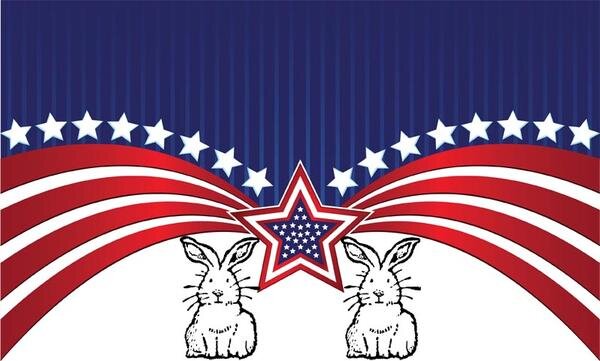|
How the Bunnies Gained Independence
By Jean Silva.
In the spirit of the fourth of July.
In the early ‘90s the County Animal Shelter, where BUNS operates, barely had enough staff to care for the dogs. The director of Animal Services was a former health educator with a passion for children but not for animals.. He was happy to have volunteers caring for animals.
When bunny lovers began to care for the rabbits no staff paid much attention. Gradually, we took on more responsibility and more rabbits. The House Rabbit Society had information about diet, housing and exercise. Dr. Haskell helped us with sanitation, disease control and veterinary care. Our friends in the Dog Adoption and Welfare Group (DAWG) let us use their non profit status and we raised money for the rabbit building. We were feeling pretty confident.
The dogs were another story. County staff and DAWG volunteers continually disagreed. The most passionate disagreements dealt with euthanasia and who would decide which dogs would die. But, the volunteers had a role in euthanasia decisions.
The disagreements reached the boiling point and a new director was hired. He was an emergency medical technician with no experience in shelter management. At first the new director spent a lot of time talking with staff and volunteers. We were hopeful that he would bring us all together to work on behalf of the the animals.
One day I arrived at the shelter to find a dog volunteer standing by a kennel sobbing. The staff had taken a dog to be euthanized with no warning. That was how DAWG volunteers learned that they no longer had a say in euthanasia. After that all volunteers were afraid. If a rabbit was left the shelter, volunteers would fear the worst. We learned to put notes on the cages and sign in sheets for rabbits that had gone to foster, the vet or had been adopted. Some days we would see a group of staff, with little smiles, carrying the red box full of euthanasia drugs and know that another dog was about to die. And, weekly, we found dog volunteers mourning over lost friends.
The County did not attempt to euthanize rabbits. Instead the new director informed us that he was moving all rabbit hutches to the Lompoc and Santa Maria Shelters. We had just finished the rabbit building. Our volunteers were talking among ourselves about giving our hutches to the other shelters. But, when the new director announced he was seizing the hutches, we said no. The hutches belonged to BUNS not to the County.
Dr. Haskell had recommended that new rabbits be held in hutches until we were sure they were healthy. The new director responded that rabbits had no value and did not merit this consideration. He did agree that we could have 2 hutches. We continued to use the hutches. One day, I arrived at the shelter to find that staff had taken an axe and demolished a hutch. The pieces were left on the ground in the rabbit area. Shortly after that the new director had staff move all the rabbit hutches to the rear of the shelter and forbade us from using them as long as they were on county property.
Enough was enough. The rabbits decided to fight. We allied with the DAWG volunteers. They had a base of public support. We had people who knew county politics. We drew up Memorandums of Understanding for both groups and presented them to the Public Health Director. We had meetings with members of the Board of Supervisors. We made contributions to political campaigns and held fund raising parties. We reached out to volunteers in Lompoc and Santa Maria and lobbied our supervisors on their behalf.The dogs and the bunnies dug deep, bit hard and would not let go.
It was a painful time. Full of stress. Each time you approached the shelter, you did not know what you would find. Or what would happen when you left. Often at night my husband and I would watch Zulu, a movie about a small band of British soldiers fighting thousands of Zulu warriors. Like them we too hoped to survive, but the outcome looked grim.
Good things did come from our efforts. BUNS and DAWG had their MOU’s approved by the Board of Supervisors. DAWG used part of a bequest and a grant to improve the kennels in Lompoc. The Director of Animal Services was removed. Supervisor Wallace, a vet, visited the Santa Maria Shelter - a derelict house that was too small for health or safety. He left in tears with a dog. A new director Jan Glick, who was an animal shelter professional, was hired as the new director. The County built a beautiful new shelter in Santa Maria.
Since that time, BUNS has had control over what happens within the fence that surrounds the rabbit area. We have been able to provide a no kill shelter in an open admission stray animal shelter. We have been very fortunate and owe a great deal to all the people who supported us, DAWG, the Board of Supervisors and to our director Jan Glick.

|